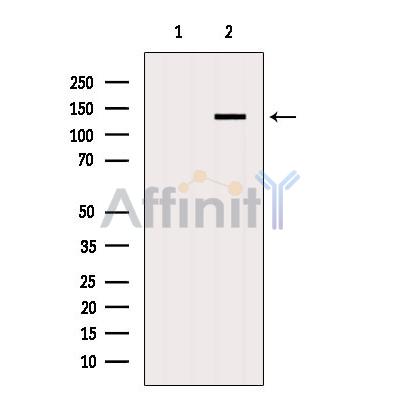AP3B1 Antibody - #DF12092
| Product: | AP3B1 Antibody |
| Catalog: | DF12092 |
| Description: | Rabbit polyclonal antibody to AP3B1 |
| Application: | WB IHC |
| Reactivity: | Human, Mouse, Rat |
| Prediction: | Bovine, Horse, Sheep, Rabbit, Dog, Chicken, Xenopus |
| Mol.Wt.: | 140 kDa; 121kD(Calculated). |
| Uniprot: | O00203 |
| RRID: | AB_2844897 |
Related Downloads
Protocols
Product Info
*The optimal dilutions should be determined by the end user.
*Tips:
WB: For western blot detection of denatured protein samples. IHC: For immunohistochemical detection of paraffin sections (IHC-p) or frozen sections (IHC-f) of tissue samples. IF/ICC: For immunofluorescence detection of cell samples. ELISA(peptide): For ELISA detection of antigenic peptide.
Cite Format: Affinity Biosciences Cat# DF12092, RRID:AB_2844897.
Fold/Unfold
Adapter related protein complex 3 beta 1 subunit; Adapter-related protein complex 3 subunit beta-1; Adaptor protein complex AP-3 subunit beta-1; Adaptor protein complex AP3 beta1 subunit; ADTB3; ADTB3A; AP-3 complex subunit beta-1; AP3 complex beta1 subunit; AP3B1; AP3B1_HUMAN; Beta-3A-adaptin; Beta3A adaptin; Clathrin assembly protein complex 3 beta 1 large chain; Clathrin assembly protein complex 3 beta-1 large chain; HPS; PE;
Immunogens
A synthesized peptide derived from human AP3B1, corresponding to a region within C-terminal amino acids.
- O00203 AP3B1_HUMAN:
- Protein BLAST With
- NCBI/
- ExPASy/
- Uniprot
MSSNSFPYNEQSGGGEATELGQEATSTISPSGAFGLFSSDLKKNEDLKQMLESNKDSAKLDAMKRIVGMIAKGKNASELFPAVVKNVASKNIEIKKLVYVYLVRYAEEQQDLALLSISTFQRALKDPNQLIRASALRVLSSIRVPIIVPIMMLAIKEASADLSPYVRKNAAHAIQKLYSLDPEQKEMLIEVIEKLLKDKSTLVAGSVVMAFEEVCPDRIDLIHKNYRKLCNLLVDVEEWGQVVIIHMLTRYARTQFVSPWKEGDELEDNGKNFYESDDDQKEKTDKKKKPYTMDPDHRLLIRNTKPLLQSRNAAVVMAVAQLYWHISPKSEAGIISKSLVRLLRSNREVQYIVLQNIATMSIQRKGMFEPYLKSFYVRSTDPTMIKTLKLEILTNLANEANISTLLREFQTYVKSQDKQFAAATIQTIGRCATNILEVTDTCLNGLVCLLSNRDEIVVAESVVVIKKLLQMQPAQHGEIIKHMAKLLDSITVPVARASILWLIGENCERVPKIAPDVLRKMAKSFTSEDDLVKLQILNLGAKLYLTNSKQTKLLTQYILNLGKYDQNYDIRDRTRFIRQLIVPNVKSGALSKYAKKIFLAQKPAPLLESPFKDRDHFQLGTLSHTLNIKATGYLELSNWPEVAPDPSVRNVEVIELAKEWTPAGKAKQENSAKKFYSESEEEEDSSDSSSDSESESGSESGEQGESGEEGDSNEDSSEDSSSEQDSESGRESGLENKRTAKRNSKAKGKSDSEDGEKENEKSKTSDSSNDESSSIEDSSSDSESESEPESESESRRVTKEKEKKTKQDRTPLTKDVSLLDLDDFNPVSTPVALPTPALSPSLMADLEGLHLSTSSSVISVSTPAFVPTKTHVLLHRMSGKGLAAHYFFPRQPCIFGDKMVSIQITLNNTTDRKIENIHIGEKKLPIGMKMHVFNPIDSLEPEGSITVSMGIDFCDSTQTASFQLCTKDDCFNVNIQPPVGELLLPVAMSEKDFKKEQGVLTGMNETSAVIIAAPQNFTPSVIFQKVVNVANVGAVPSGQDNIHRFAAKTVHSGSLMLVTVELKEGSTAQLIINTEKTVIGSVLLRELKPVLSQG
Predictions
Score>80(red) has high confidence and is suggested to be used for WB detection. *The prediction model is mainly based on the alignment of immunogen sequences, the results are for reference only, not as the basis of quality assurance.
High(score>80) Medium(80>score>50) Low(score<50) No confidence
Research Backgrounds
Subunit of non-clathrin- and clathrin-associated adaptor protein complex 3 (AP-3) that plays a role in protein sorting in the late-Golgi/trans-Golgi network (TGN) and/or endosomes. The AP complexes mediate both the recruitment of clathrin to membranes and the recognition of sorting signals within the cytosolic tails of transmembrane cargo molecules. AP-3 appears to be involved in the sorting of a subset of transmembrane proteins targeted to lysosomes and lysosome-related organelles. In concert with the BLOC-1 complex, AP-3 is required to target cargos into vesicles assembled at cell bodies for delivery into neurites and nerve terminals.
Phosphorylated on serine residues.
Cytoplasmic vesicle>Clathrin-coated vesicle membrane>Peripheral membrane protein>Cytoplasmic side. Golgi apparatus.
Note: Component of the coat surrounding the cytoplasmic face of coated vesicles located at the Golgi complex.
Ubiquitously expressed.
Belongs to the adaptor complexes large subunit family.
Research Fields
· Cellular Processes > Transport and catabolism > Lysosome. (View pathway)
Restrictive clause
Affinity Biosciences tests all products strictly. Citations are provided as a resource for additional applications that have not been validated by Affinity Biosciences. Please choose the appropriate format for each application and consult Materials and Methods sections for additional details about the use of any product in these publications.
For Research Use Only.
Not for use in diagnostic or therapeutic procedures. Not for resale. Not for distribution without written consent. Affinity Biosciences will not be held responsible for patent infringement or other violations that may occur with the use of our products. Affinity Biosciences, Affinity Biosciences Logo and all other trademarks are the property of Affinity Biosciences LTD.









